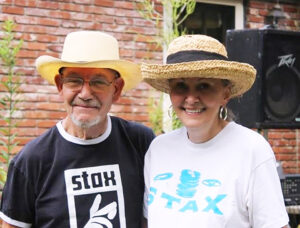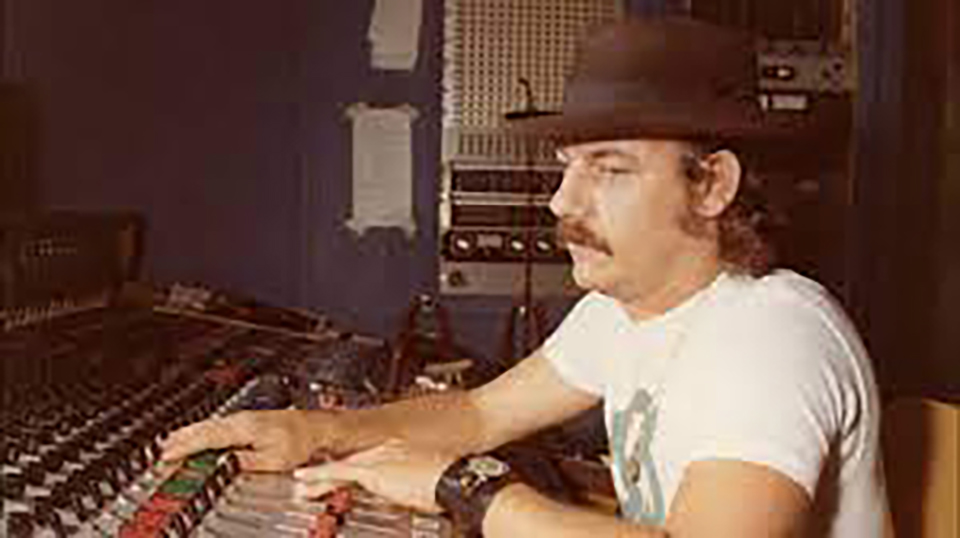Ten years have passed since the debut of Muscle Shoals, the documentary that introduced the rest of the world to the music that came out of North Alabama. That film could have—perhaps should have—served as a series pilot. Some of the stories that remained untold are just as rich.
On Saturday, March 18, friends and family of Jerry Masters gathered to hear his account of his fascinating life as a performer and a sound engineer for some of the biggest names in every genre of music. In an intimate setting with his wife Jan adding details and his brother-in-law Tim Stevenson helping to direct the narrative, Masters shared his perspective on some of the best-known songs and singers of several decades.

Masters was shaped by his childhood in Little Rock, Arkansas, where he was forced as an eight-year-old to take on a parental role to his younger brothers when his father left. His mother played on the out-of-tune piano on the other side of the wall from the room where he slept.
“She played piano—what I call ‘boom chicka boom’—playing her own bass line with her left hand. I tried to play along with a friend’s guitar, but I couldn’t match bass line,” said Masters.
One night, though, during a party, a guitar came in and it was a band. “That’s the night the music came into me, and I knew that music was supposed to be my life.”
Masters wanted a guitar but didn’t see a way until he came across an ad in a comic book suggesting he could sell enough Christmas cards to earn a guitar. That winter, he went door to door in the freezing weather. He finally sold enough cards to get a guitar, but when it arrived and he put on the plastic strings, the neck just bent. “I knew it was not going to work, but I never gave up.”
He finally got a guitar and played all through high school. Even though the school had over 3000 students and a huge band, they’d never had a guitar player before Masters.During the time, he fell in love with jazz, which he says has remained his number one love in music.
During junior high school, he often called in requests to the local radio station deejay a Sunday jazz show. If the deejay didn’t have the records, Masters let him borrow his copies. Years later, when he met Al Bell while working on the Staples Singers’ “I’ll Take You There,” he learned that Bell was that same deejay in Little Rock.
Playing guitar, Master says, was like playing tennis: he reached a point where he felt he couldn’t get any better. While playing, he asked, “Lord, can’t I ever be anything more than just average?”
He said he heard a response: “What if I told you that you would just be average at everything you do. Can you live with that?” He replied, “Yes, Lord, I can.
After high school, he joined the Army and was sent to Ft. Devin, Massachusetts, after basic training. He had a new guitar and amp, a gift from his mother. From there, he was assigned to Okinawa. Before leaving, he visited Little Rock taking a more than three-day train trip, where his grandfather was on his death bed.
“I had so much stuff, a duffle bag full of my personal stuff and my heavy guitar and amp. If I’d had to take my guitar and amp, I’d have never made it,” he said, “but my best friend, a piano player, said, ‘Go on and I’ll send it to you,’ because he knew where I was going. And I’m still waiting for my guitar. and my amp.”
When he reached Okinawa, Masters went to special services and asked if they had a guitar he could borrow. All they had, though, was an old upright bass. Although he had never played bass before, he told them, “I’ll take anything that’s got strings on it that won’t bend double.” Knowing the strings on a bass matched the bottom four on a guitar, he figured how to play the bass purely with perseverance.
For a small island, he said, Okinawa had lots of musicians. He joined Sunday jam sessions at the Air Force enlisted men’s club, where musicians got free drinks. A lot of the musicians he met there came from the Philippines, which had only one music school—a percussion school. Fortunately, he said, the piano is considered a percussion instrument. He continued to learn from other musicians and kept practicing. He had to leave the instrument behind when his duty ended, but he bought an old bass from a pawn shop. He admits he mistook the sound post for a peg to balance the bass, he says, so he ended up with calluses from the tips of his fingers to his wrist from trying to play louder. When he eventually bought a new Kay bass, he says, he didn’t need an amplifier.
Along the way, Masters also realized he had a good ear. He knew how music was supposed to sound. “People in Muscle Shoals used to say I could hear a rat peeing on cotton in Kansas City,” he said.
When Masters got out of the Army, he and his band started playing at a lakefront club in Hot Springs, Arkansas, with Buddy Rogers on drums. Charlie Rich came in one night because he was supposed to play in there the following week and heard Masters’ band. “When he heard us, he said, ‘I want that bass player and that drummer. I don’t want anyone else to ever play with me but those two. We’ll get a guitar player later if we need one.” Masters went on to play with Rich, served as band manager, and did all the driving for the band, but the Nashville political machine, he says, didn’t let him play on sessions when Rich recorded.
Masters shared that in 1967, the agent who booked Charlie Rich, Ace Cannon, Jerry Lee Lewis and more, booked Masters to play bass and help put together a band for a tour to promote Ronnie and the Daytona’s iconic hit “Little GTO.” Since it was actually a studio song, there was no Ronnie and the Daytonas. They assembled the right combination of band members, but finally grew tired of the road and pretending to be someone they were not. They landed a sit-down gig at a Mexican Restaurant and lounge in West Memphis, Arkansas, where he said the band got better and better.
He told the story of a road trip to Houston to record an album as the Hombres. He drove a long Cadillac pulling a trailer with all the instruments about five in the morning on Highway 59 between Texarkana and Houston, when they topped the hill and came upon a fiasco: a truck hauling chickens had hit a bridge abutment, and chickens were everywhere.
“There were live chickens, dead chickens, and half-live chickens,” said Masters. When he said, “Hey boys, y’all wake up. We’ve got us a chicken wreck here,” one of his bandmates opened one eye and said, “Well, just let it all hang out.”
As Jerry pointed out, this was during the war in Vietnam when so many songs on the radio were protest songs or songs about something negative in politics. He told the band they needed to put out a song that would liven people up. He challenged each band member to write a verse, telling them to “make sure that it makes no sense whatsoever—just let it all hang out.”
The song they created from that hook line “Let It All Hang Out” was an overnight hit, an immediate million seller, but, he added, “It upset every church in the world. They formed committees to break down our verses. We knew it had nothing to do with politics”:
It’s raining inside a big brown moon
How does that mess you baby up, leg
Eatin’ a Reuben sandwich sauerkraut
Don’t stop now, baby, let it all hang out. . .
Masters says the song lifted people up and made them feel good. Sometimes when it came on the radio, people pulled off to the side of the road, get out, and dance.
After touring again, the band members grew tired of the road and wanted to shut it down. Masters says he was the only one that wanted to keep the band together, while the others wanted to work in a studio. Ironically, he was the only one that ended up working in a recording studio.
His friend Bill Black, Elvis’s bass player, had a Memphis studio. Jerry realized they did most of the recording at night, so he asked if he could “come in and fiddle around” since he didn’t know anything about engineering. Since he was playing a club from nine in the evening until two in the morning, he was out before they came to record. After his gigs, he’d make the 25-mile drive back home and then be back at the studio the next morning to teach himself to engineer.
Masters’ first trip Muscle Shoals resulted from a phone call from Travis Wammack, a Memphis friend who had moved to Muscle Shoals the year before to work with Rick Hall at Fame Studio. Masters was booked to play bass on the session with the four original Swampers when Clarence Carter recorded what became his huge hit “Patches.”
“I think it was the first #1 with a bullet record to come out of Muscle Shoals, and it had my signature on it because I did something on the intro and in the middle playing high on the bridge. Rick never said a word about it, just let me do what I wanted to do because he didn’t know me,” said Masters.
He knew at once his heart was in Muscle Shoals. He had been playing five hours a night for ninety dollars a week at the club in Memphis. Part of the draw was Jan, the charming young woman he met there, now his wife. When he got ready to leave, he asked for a job, but Hall said he didn’t need a full-time bass player. Masters replied, “Yeah, but I’m an engineer too.”

At the time, he had never done a session, but he knew how a band should sound. With an offer of a hundred dollars a week, he moved his family to Muscle Shoals in a bean truck.
As he reinvented himself, he learned the ropes to become a sound engineer during the period when Muscle Shoals Sound expanded beyond R&B. He worked with Rick Hall at Fame for a couple of years, and then the guys at the 3614 Jackson Highway studio asked him to edit for them. When they came to see if he could do what they wanted, he said it took him about five minutes. “I was razor blade captain. I wasn’t afraid to cut tape, man,” he said.
Jerry Masters saw the Muscle Shoals Sound expand to new genres. He worked with the Staples Singers on “Respect Yourself, which became his first gold record and “I’ll Take You There,” his first platinum record. His next was “If Loving You Is Wrong, I Don’t Want to Be Right” by Luther Ingram.
For years, he notes, everybody considered Muscle Shoals basically an R & B town, with no pop artists recording until someone told Paul Simon about the studio. Phil Ramone was producing Simon’s album There Goes Rhymin’ Simon, so they flew in to the check out the studio.
When they arrived, the old building on Jackson Highway, a former casket factory, had a bad leak, which Masters had rigged with Kotex and thumbtacks. Ramone and Simon appeared to be thinking, “So this is Muscle Shoals.”
“Nobody knew if we could cut pop records or not,” said Masters, “And then we cut ‘Kodachrome.’” The session also produced such hits as “Love Me Like a Rock” and “Take Me to the Mardi Gras,” for which they went to New Orleans to add funeral horns to the recording. He also worked with Ramone when Paul Simon and Art Garfunkel decided to record one more song together for old time’s sake. Near the end of the session, seeing he was near the end of the tape and not wanting to spoil the musicians’ hot vibe, Masters cut the tape speed, despite Ramone’s exacting requirements. When he told Ramone what he’d done after the session, “he went ballistic,” but Masters told him, “If this record sells a million copies, I’ll never let you forget it.” The song, “My Little Town,” went on to sell 1.8 million copies.
Once the genre barrier was broken and pop artists began recording in Muscle Shoals, Willie Nelson came to the studio to record Phases and Stages, ostensibly influenced by his marriage that was coming to an end. Nelson brought in Johnny Gimble on fiddle and Fred Carter on dobro and guitar to play with the Swampers on the album.
Jerry Masters remains a repository of a wealth of music history. He shared one thing he learned: “To be a good engineer, you’ve got to have good ears. To be a good engineer/producer, you’ve got to have good relationships.” Without question, he put that listening skill to work not only in the studio but also in building those priceless relationships. Along with all his stories of taking Liza Minelli to McDonalds or Paul Simon ordering “one grit” for breakfast, Masters has countless other stories of those lesser known studio musicians he knew by name who made the magic that was the Muscle Shoals sound.

